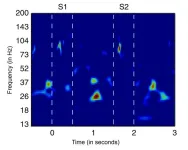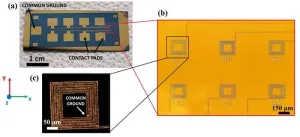Majority of acute care hospitals do not admit representative proportion of Black Medicare patients in their local market
Some admit more, some admit fewer; analysis suggests racial sorting in U.S. hospital admissions exists independent of neighborhood demographics
2024-04-23
(Press-News.org)
A study analyzing a large sample of Medicare admissions at nearly 2,000 acute care hospitals nationwide during 2019 found that most hospitals—nearly four out of five—admitted a significantly different proportion of Black fee-for-service Medicare patients age 65 and older compared to the proportion of the same group of patients admitted to any hospital in that hospital’s market area.
The researchers say that understanding hospital choices within neighborhoods and markets could help reduce racial inequities in health outcomes.
The study, published online April 19 in JAMA Network Open, was led by a researcher at the Johns Hopkins Bloomberg School of Public Health, with colleagues from Dartmouth.
For their study, the researchers compared the proportion of Black Medicare admissions at a hospital to the racial composition of admissions to any hospital in the same market—defined as zip codes within a 30-minute drive from the hospital. The analysis of 1,991 hospitals found that 79.4 percent of hospitals admitted a significantly different proportion of Black Medicare patients compared to the proportion admitted in the surrounding hospital market—with 34.4 percent admitting significantly fewer Black patients relative to the surrounding hospital market, and 45.0 percent admitting significantly more.
The study also found that this racial sorting effect was especially common in areas of the U.S. with large concentrations of Black residents.
“These findings tell us that there are other factors besides local residential segregation that cause the racial sorting of hospital patients,” says study lead author Ellesse-Roselee Akré, an assistant professor in the Bloomberg School’s Department of Health Policy and Management. “The next question is how might this differential sorting influence health outcomes and racial inequities.”
While U.S. hospitals are prohibited from discriminating against patients on the basis of race, some hospitals end up with disproportionately fewer or greater Black patients that live in the relative area. This differential sorting may help explain persistent inequities in access to quality health care.
Differential sorting associated with hospitals has been thought to be due in part to the geographic isolation that results from residential racial segregation that persists in society. The aim of the new study was to explore whether the racial composition of hospital admissions reflects the composition of surrounding neighborhoods—or more particularly, the composition of all patients coming to local hospitals from those neighborhoods.
“If everyone has equitable access to local hospitals, then the admissions at one hospital should be representative of the surrounding area,” Akré says.
For their study, the researchers developed a measure they call the Local Hospital Segregation index, which takes the percentage of a racial group in a given hospital’s admissions and subtracts the percentage of that race in all hospital admissions in the surrounding area—defined as zip codes within 30 minutes driving time. The researchers think this is the first such metric that measures hospital segregation in hospital admissions in hospital markets.
Using this measure, they examined Medicare admissions covering 4,870,252 patients in a sample of 1,991 different hospitals across the U.S. during 2019. Half of hospitalizations among Black Medicare patients occurred at 235 hospitals or 11.8 percent of all hospitals in the sample. The analysis identified 878 hospitals (34.4 percent) exhibiting a negative Local Hospital Segregation score—admitting fewer Black Medicare patients relative to the local hospital market—while 1,113 hospitals (45.0 percent) exhibited a positive Local Hospital Segregation score, admitting more Black patients relative to their local hospital market.
The study did not examine the consequences of this racial sorting. The researchers say they are currently investigating the impact of racial hospital sorting, as it likely has relevance to racial inequities in health outcomes. Hospitals that admit a disproportionate number of Black patients may have lower care quality, for example, as some prior studies have found. Akré and her colleagues plan to use this novel measure to examine the relationship between patient sorting and hospital quality using the Centers for Medicare & Medicaid Services’ Overall Hospital Quality Star Rating.
“Measuring Local-Area Racial Segregation for Medicare Hospital Admissions” was written by Ellesse-Roselee Akré, Deanna Chyn, Heather Carlos, Amber Barnato, and Jonathan Skinner.
Support for the research was a diversity supplement to Ellesse-Roselee Akré (National Institute on Aging P01-AG19783) and the GeoSpatial Program Area at Dartmouth.
# # #
END
ELSE PRESS RELEASES FROM THIS DATE:
2024-04-23
In a study of patients who smoked when they were diagnosed with laryngeal cancer, those who quit smoking before starting chemotherapy or radiation responded better to treatment, were less likely to need their voice boxes surgically removed, and lived significantly longer than those who continued to smoke. The research, from the University of Oklahoma, is published in the journal Otolaryngology-Head and Neck Surgery.
The study’s lead author, Lurdes Queimado, M.D., Ph.D., said the findings underscore the importance of integrating tobacco cessation programs into treatment plans for cancer of the larynx, an area of the throat involved in breathing, swallowing ...
2024-04-23
ALBUQUERQUE, N.M. — Sandia National Laboratories and the Kansas City National Security Campus completed a crucial weapons component development milestone, prior to full rate production.
The Mark 21 Replacement Fuze interfaces with the W87-0 warhead for deployment onto the Minuteman III and, eventually, the Sentinel Intercontinental Ballistic Missile.
The first production unit of the replacement fuze was approved through the National Nuclear Security Administration’s rigorous Quality Assurance Inspection Procedure ...
2024-04-23
WASHINGTON, D.C. – The Patient-Centered Outcomes Research Institute (PCORI) today announced the approval of funding awards totaling more than $150 million to support new patient-centered comparative clinical effectiveness research (CER) studies, research to strengthen the rigor and quality of patient-centered CER and a project to implement the findings of PCORI-funded research into practice.
Among the nine awards for patient-centered CER, two include support for large, two-phased trials comparing approaches to treatments for heart failure and asthma. Two other large studies will compare health system strategies to improve hypertension control, and another will evaluate ...
2024-04-23
Human beings are likely to adopt the thoughts, beliefs, and behaviors of those around them.
Simple decisions like what local store is best to shop at to more complex ones like vaccinating a child are influenced by these behavior patterns and social discourse.
“We choose to be in networks, both offline and online, that are compatible with our own thinking,” explained Amin Rahimian, assistant professor of industrial engineering at the University of Pittsburgh Swanson School of Engineering. “The social contagion of behavior through networks can help ...
2024-04-23
In a new study published in Nature Chemistry, UNC-Chapel Hill researcher Ronit Freeman and her colleagues describe the steps they took to manipulate DNA and proteins — essential building blocks of life — to create cells that look and act like cells from the body. This accomplishment, a first in the field, has implications for efforts in regenerative medicine, drug delivery systems, and diagnostic tools.
“With this discovery, we can think of engineering fabrics or tissues that can be sensitive to changes in their environment and behave in dynamic ways,” says Freeman, whose lab is in the Applied Physical Sciences Department of the UNC College ...
2024-04-23
To properly protect forests and evaluate the state of natural resources, conservation practices and environmental policies, it is important to have accurate information on an area’s forest extent. One of the challenges facing researchers when it comes to evaluating the accuracy of forest extent, however, is that models use different remote sensing products that may have different definitions for what determines forest extent. In addition, on the ground surveys may sometimes come into conflict with what remote, satellite-based products are describing as forests.
To help quantify this problem, a group of researchers from ...
2024-04-23
The brain processes information on many scales. Individual cells electrochemically transmit signals in circuits but at the large scale required to produce cognition, millions of cells act in concert, driven by rhythmic signals at varying frequencies. Studying one frequency range in particular, beta rhythms between about 14-30 Hz, holds the key to understanding how the brain controls cognitive processes—or loses control in some disorders—a team of neuroscientists argues in a new review article.
Drawing on experimental ...
2024-04-23
We use computers to help us make (hopefully) unbiased decisions. The problem is that machine-learning algorithms do not always make fair classifications, if human bias is embedded in the data used to train them — which is often the case in practice. To ease this "garbage in, garbage out" situation, a research team presented a flexible framework for mitigating bias in machine classification. Their research was published Apr. 8 in Intelligent Computing, a Science Partner Journal.
Existing attempts to mitigate classification bias, according to the team, are often held back by their reliance on specific metrics of fairness and predetermined ...
2024-04-23
In the nine decades since humans first produced fusion reactions, only a few fusion technologies have demonstrated the ability to make a thermal fusion plasma with electron temperatures hotter than 10 million degrees Celsius, roughly the temperature of the core of the sun. Zap Energy’s unique approach, known as a sheared-flow-stabilized Z pinch, has now joined those rarefied ranks, far exceeding this plasma temperature milestone in a device that is a fraction of the scale of other fusion systems.
A new research paper, published this month in Physical ...
2024-04-23
WASHINGTON, April 23, 2024 — Neural stimulation is a medical technique used to treat many illnesses affecting the nervous system. It involves applying energy to neurons to encourage them to grow and make connections with their neighbors. Treatments for epilepsy can often include neural stimulation, and similar treatments exist for Parkinson’s disease, chronic pain, and some psychiatric illnesses.
In the Journal of Vacuum Science & Technology A, by AIP Publishing, researchers from the University of Minnesota deployed an array of microscopic coils — microcoils — to create ...
LAST 30 PRESS RELEASES:
[Press-News.org] Majority of acute care hospitals do not admit representative proportion of Black Medicare patients in their local market
Some admit more, some admit fewer; analysis suggests racial sorting in U.S. hospital admissions exists independent of neighborhood demographics







